This post contains affiliate links, which means I may earn a commission if you purchase through those links (at no extra cost to you).
I grew up making Orange Marmalade the old-fashioned way: soaking citrus overnight and boiling it rigorously to extract the natural pectin in the rind. When you follow my technique, you don’t need to add any store-bought pectin, and you get the best, cleanest-tasting marmalade.

Nearly 1,000 5-star reviews prove this unfussy technique is simple and easy to follow. I also include my handy “cold plate test” so you can know for sure whether your marmalade is done or needs a little bit more time on the stove.
Home cooks everywhere are putting their abundant citrus to use to make their own homemade marmalade, and now you can, too. This recipe makes about 3 quarts total, or 12 (8 ounce jars). It freezes beautifully or you can process it in a water bath for canning.
Table of Contents
Marmalade Ingredients
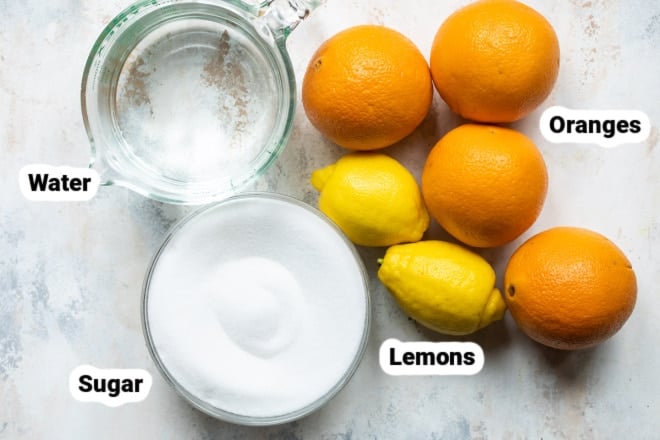
At a Glance: Here is a quick snapshot of what ingredients are in this recipe.
Please see the recipe card below for specific quantities.
- Oranges: This recipe is made with regular seedless oranges. You can definitely substitute Seville oranges if you can find them. They are only in season from the end of January to mid-February, but they have an intense flavor that is ideal for marmalade.
How to make Orange Marmalade
- Using a sharp knife, cut oranges and lemons in half crosswise, then into very thin half-moon slices. Discard any seeds. In a large pot (stainless steel), add the sliced oranges, lemons, and any fruit juice.
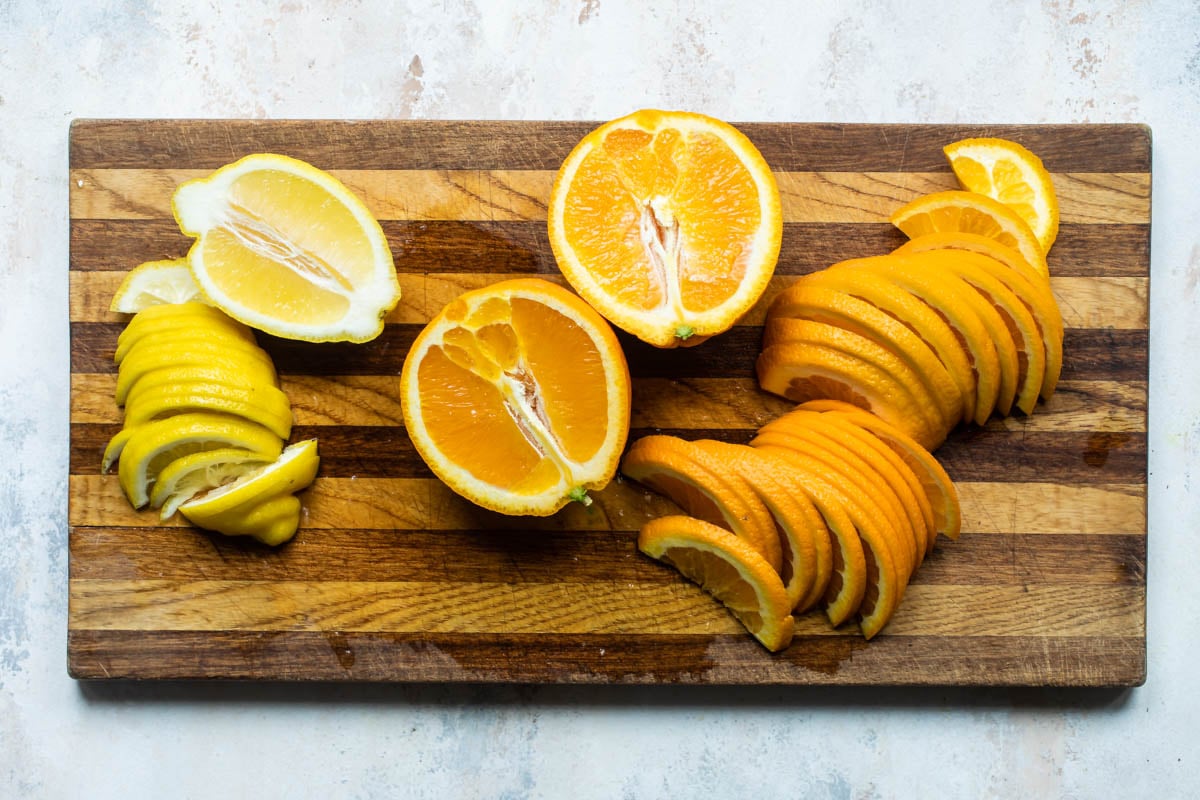
- Add water and bring the mixture to a boil over medium heat, stirring often. Remove from the heat and stir in the sugar until it dissolves. Cover and let stand overnight at room temperature.
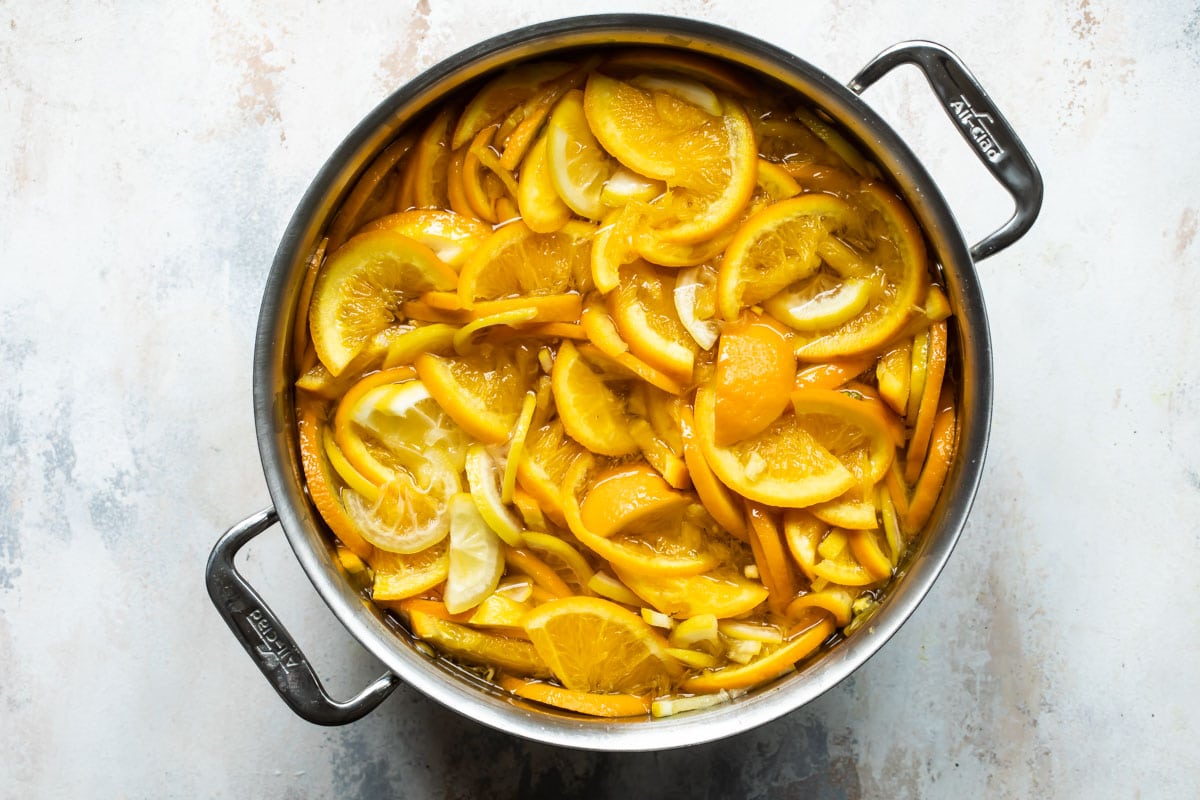
- The next day, bring the mixture back to a boil in the pot or saucepan. Reduce heat to low and simmer uncovered for 2 hours. Turn heat up to medium and boil gently, stirring often, for another 30 minutes. Skim off any foam that forms on the top. Cook until it reaches 220 degrees on a candy thermometer (you must hit this temperature for the natural pectin to gel with the sugar).

- To test if the marmalade is ready, place a small amount on a plate and refrigerate it until it’s cool but not cold. If it’s firm (neither runny nor hard), it’s ready. It will be a golden orange color. If it’s still runny, continue cooking it; if it’s hard, add a bit more water.

- Pour or ladle the marmalade into clean hot mason jars (I use this wide-mouth jar funnel for this recipe and so many others). Wipe the rims thoroughly with a clean damp paper towel, and seal with the lids. Chill in the refrigerator. It may take 24-48 hours for the natural pectin to set up properly.
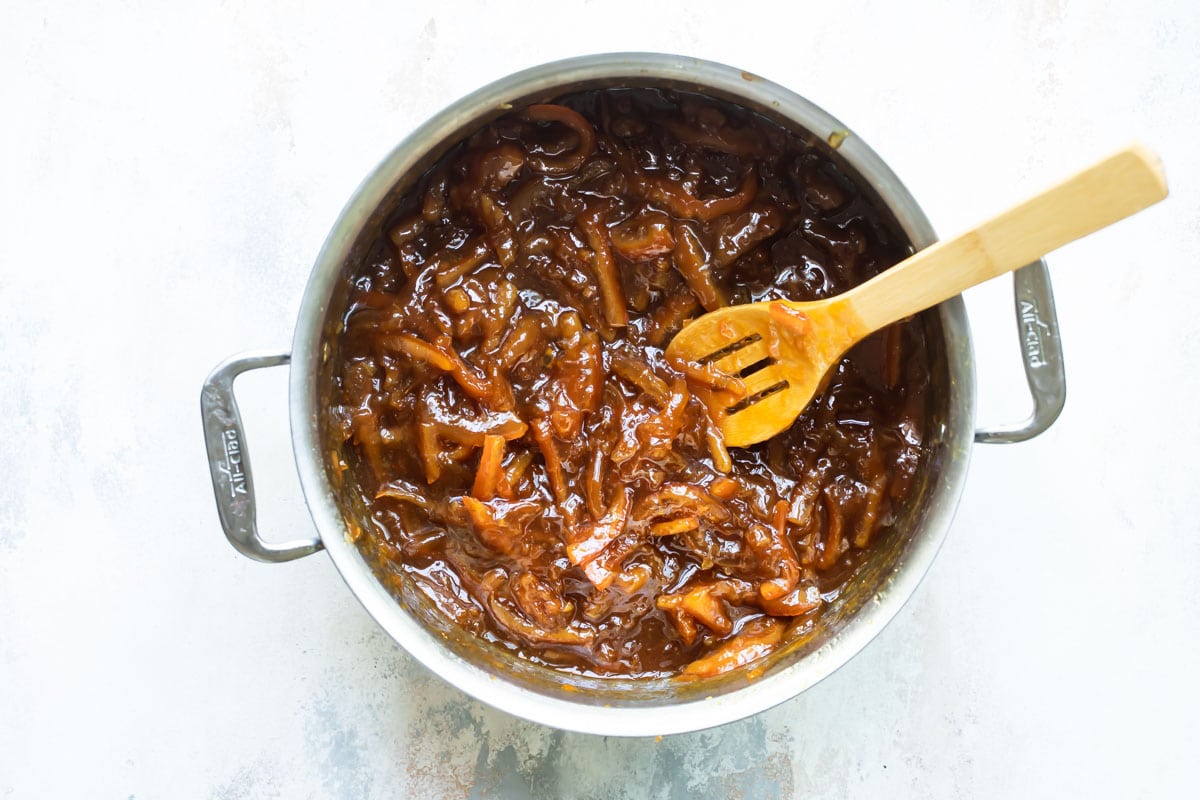
Orange Marmalade Recipe Variations
- Pectin: While many jam and jelly recipes require added pectin, you don’t need to add any here. Pectin is naturally concentrated in the pith of the orange (the bitter white part under the peel). This recipe coaxes out that natural pectin by letting the citrus soak overnight and then boiling it rapidly until enough water has evaporated that the mixture can reach 220 degrees.
- Agave nectar: Agave cannot penetrate and sweeten the peel as well as sugar can. When I tested it, the consistency was fine, but the rind tasted like raw rind. I don’t recommend this substitution.
- Low sugar: I haven’t tested low-sugar/alternative sweeteners in this recipe other than agave as listed above nor have I tweaked the amount of sugar in the recipe. I recommend seeking out recipes from experts in that area.
- Slow cooker: While it is technically possible to make marmalade in your slow cooker, it really depends on the power of your appliance. I no longer recommend that method because it isn’t reliable enough.
- Instant pot: Even with an overnight soak, the IP doesn’t break down the rind sufficiently. I don’t recommend this method.
Marmalade Recipe Tips
- Yield: This recipe makes about 3 quarts (96 ounces) of marmalade.
- If using 1/2-pint (8 ounce) jars, you’ll need 12.
- If using 1 pint (16 ounce) jars, you’ll need 6.
- If using the tiny jelly jars (4 ounce), you’ll need 24.
- Cold-plate test: To test if your marmalade is ready, spoon some hot marmalade on to a small plate and put it in the freezer to chill, or spoon some over an icy cold plate fresh from the freezer. If the mixture wrinkles slightly when you draw a spoon or finger across it, it has reached the setting point and is ready to go! If not, keep boiling and make sure the temperature reaches 220 degrees.
- Set-up time: Orange marmalade takes 24-48 hours for the natural pectin to set up completely. If it’s is still a little runny looking when it cools, check again in a day or two.

Storing and Canning Orange Marmalade
Storage: Store covered in the refrigerator for up to 1 month.
Freezer: Pack in freezer-safe containers or jars leaving 1/2-inch of headspace for expansion. Label, date, and freeze for up to 3 months. Thaw overnight in the refrigerator.
Canning: If putting up for storage, use a hot water or steam canner with a rack to properly seal lids on canning jars according to canning instructions. Otherwise, refrigerate and use within the month. Or, freeze for up to 3 months.
Frequently Asked Questions
Pectin is naturally concentrated in the pith of the orange (the bitter white part under the peel), so you don’t need to add any here. This recipe coaxes out that natural pectin by letting the citrus soak overnight and then boiling it rapidly until enough water has evaporated that the mixture can reach 220 degrees.
While it is technically possible to make marmalade in your slow cooker, it really depends on the power of your appliance. I no longer recommend that method because it isn’t reliable enough.
Even with an overnight soak, the IP doesn’t break down the rind sufficiently. I don’t recommend this method.
Agave cannot penetrate and sweeten the peel as well as sugar can. When I tested it, the consistency was fine, but the rind tasted like raw rind. I don’t recommend this substitution.
I don’t recommend making this recipe in a regular cast iron pan. It should be made in a non-reactive pan. Enameled cast iron, stainless steel, and non-stick are best and will not affect the color or taste of the marmalade
More fruit recipes
Pie and Tart Recipes
Fresh Fruit Tart
Fruit Dessert Recipes
Apple Crisp with Oatmeal
Cake Recipes
Lemon Bundt Cake Recipe
Muffins and Quick Breads
Banana Muffins
Join Us
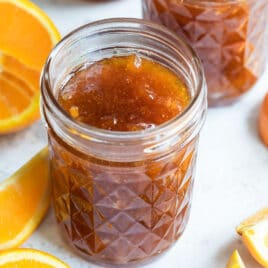
Orange Marmalade
Equipment
- Jar funnel (for wide mouth jars)
Ingredients
- 4 large seedless oranges scrubbed clean (about 3 pounds or 8 cups slices, see note 1)
- 2 lemons (about ½ pound or 1 cup slices)
- 8 cups water
- 8 cups granulated sugar
Instructions
- Cut oranges and lemons in half crosswise, then into very thin half-moon slices. Discard any seeds. In a large stainless steel pot, add the sliced oranges, lemons, and any accumulated juices.
- Add water and bring the mixture to a boil, stirring often. Remove from the heat and stir in the sugar until it dissolves. Cover and let stand overnight at room temperature.
- The next day, bring the mixture back to a boil. Reduce heat to low and simmer uncovered for 2 hours. Turn heat up to medium and boil gently, stirring often, for another 30 minutes.
- Skim off any foam that forms on the top. Cook the marmalade until it reaches 220 degrees (you must hit this temperature for the natural pectin to gel with the sugar).
- To test if the marmalade is ready, place a small amount on a plate and refrigerate it until it's cool but not cold (see note 4). If it's firm (neither runny nor hard), it's ready. It will be a golden orange color. If the marmalade is runny, continue cooking it; if it's hard, add a bit more water.
- Pour the marmalade into clean hot mason jars; wipe the rims thoroughly with a clean damp paper towel, and seal with the lids. Chill in the refrigerator. It may take 24-48 hours for the natural pectin to set up properly.
Recipe Video
Notes
- Oranges: This recipe is made with regular seedless oranges. You can definitely substitute Seville oranges if you can find them. They are only in season from the end of January to mid-February, but they have an intense flavor that is ideal for marmalade.
- Yield: This recipe makes about 3 quarts (96 ounces) of marmalade.
- If using 1/2-pint (8 ounce) jars, you’ll need 12.
- If using 1 pint (16 ounce) jars, you’ll need 6.
- If using the tiny jelly jars (4 ounce), you’ll need 24.
- Storage: Store covered in the refrigerator for up to 1 month.
- Cold-plate test: To test if your marmalade is ready, spoon some hot marmalade on to a plate and put it in the freezer to chill, or spoon some over an icy cold plate fresh from the freezer. If the mixture wrinkles slightly when you draw a spoon or finger across it, it has reached the setting point and is ready to go! If not, keep boiling and make sure the temperature reaches 220 degrees.

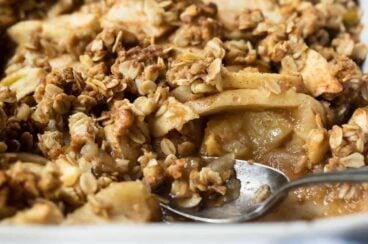

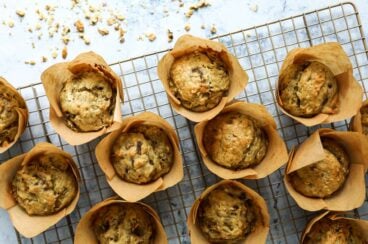
Great recipe and I’m excited to try. Had a question about using Mandarins instead of naval oranges as I have an abundance of mandarin oranges. Will this alter the recipe in any way?
Hi Sonia! They work great as a substitute, just make sure to use about 3 pounds if you’re making 1 full recipe. I hope you love it! – Meggan
Nice recipe! I’ve made two batches over the last 6 months, which seems to be the timing for a certain grocery store chain to offer oranges at a very low (like $.50/lb) prices. The first time I cooked too long (blame the thermometer ;>) and the jam set too firm. It was easy to thin later when a jar was opened (and my wife liked crushed pineapple added). The second batch I double-checked with an instant read and turned off the heat just at 120 and kept stirring until it settled down naturally, and I’m very happy with the consistency. I use a grease splatter shield when open cooking jams and jellies to reduce the mess on the stove. I heat process the jars using a steam canner, which is much faster, less water, and less energy than a water bath canner. Again – awesome. Thanks for sharing!
You’re so welcome, Richard! Great tip about using the splatter shield, thanks for sharing it! Take care and please write again if you have any questions! – Meggan
Just made this lovely recipe! Added a pineapple as well, and I had a question! I am canning the recipe but I blended my marmalade because we don’t really like thick textures. I like the flavor but the thickness definitely made it difficult getting up to temperature and prolonged the process which is fine. It was my own fault for not waiting until the end. But would this affect the canning process also? I’m going to attempt to water bath can anyway for a longer duration. But any recommendation?
Hi Kimber, it’s great you’re planning to extend the water bath time, but besides the texture, I don’t think blending the marmalade would have any other effect on the marmalade. The addition of pineapple sounds delicious! Thanks for writing and please let me know if you have any other questions! – Meggan
Great recipe thanks! I’ve made 3 batches, one with dark cane sugar, one all white granulated and one with reduced sugar (5 cups / 1kg brown cane) & I added 6 cloves for a slight warmth. All variations worked perfectly and the marmalade is. delicious. I used sweet Spanish oranges from my tree. Will try it next with Seville oranges.
I’m so happy you loved them, Alison! I love all the variations, yum! – Meggan
I’m in South Africa. Your recipies are stunning.
And your website is colorful, well laid out and fun.
Thank you for your efforts, Meggan.
Please pass my compliments to your team
You’re so welcome, Ron! Thank you for your kind words. Please write if you have any questions about the recipes! – Meggan
I have made this several times and have refined my process – I like long slices on my toast – but went overboard one time. Also need to be very careful NOT to burn the mixture when cooking it down – did that but managed to salvage most. Last time was very careful and it was best ever. This time I am trying the greener oranges as I dont want to wait for my oranges on my tree to ripen and several other sites claim that it can be a good way to use greener oranges. Great recipe – great instructions.
Hi Bill, thank you so much for writing! I’m so happy you were able to salvage some of the last batch. It’s so sad when that happens. Please write me again to update on how the greener oranges turn out in your marmalade! I’m curious to try it myself. Thanks so much, take care! – Meggan
Hi Meggan
I made your Marmalade twice which turned out fantastic. Beautiful colour and taste.
However, the last two times, the pectin does not set.
I followed the recipe step by step, reached 225 degree.
I throughout the last marmalade, which did not sit, but I don’t want to throw away the one I made last night. what should I do? Do you have any suggestions? Why he does not set? The only difference is that I bought a new bag of sugar, with different kind of sugar affects it? I bought my sugar from Costco.
Thanks a lot.
Mary-Christine
Hi Mary-Christine, I’m so sorry the batches are runny! I believe the oranges and lemon may be the cause, as long as sugar was granulated sugar and not raw sugar. (Another reader ran into issues when using raw sugar.) They may have not had a lot of pectin and not been able to gel with the sugar.
You can return the pot to heat and continue cooking the marmalade longer. (To test if the marmalade is ready, place a small amount on a plate and refrigerate it until it’s cool but not cold. If it’s firm (neither runny nor hard), it’s ready. It will be a golden orange color. If the marmalade is still runny, continue cooking it; if it’s hard, add a bit more water.)
I hope this helps! Please write again if you have any more issues! – Meggan
Can overnight be as long as from one evening to the next?
Hi Rosie, it’s absolutely fine to soak longer than 8 hours, so an entire day shouldn’t be an issue. Soaking is to soften the fruit and the peels and I’ve definitely soaked them longer than 8 hours. I don’t know if there is a maximum time, but the longer it soaks the softer the peels should be. – Meggan
Hello!
Is it safe to make this in a cast iron staub or le cruset? Not with a white enameled internal bottom?
Thanks!
Hi Tierney, it needs to be made in a non-reactive pot, so non-enameled cast iron won’t work well here. It could react with the marmalade’s color and taste. Enameled, stainless, or non-stick is the best to use. Sorry about that! Take care and please let me know if you have any more questions! – Meggan
Hi there! I’m so excited to try your recipe – it sounds delicious! My mom asked me to make a batch for her, but extra chunky. Is getting that texture as simple as cutting bigger slices, or would that mess up the recipe? Thanks so much!
Hi Jane, thanks for writing! You can cut the slices a little thicker, but if you do cut them too thick, the marmalade may not thicken up and may have a more tangy flavor. One reader shared they use an immersion blender to cut up the rind at the end, this may work too to help create chunks rather than longer slices of rind. I hope you both love it! – Meggan